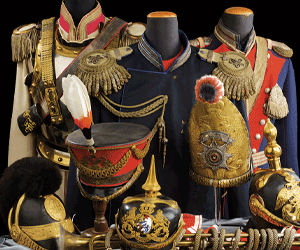Order of Franz Joseph, Type II, Military Division, Officer
SKU: 01.AUT.0111.206.01
Estimated market value:


Estimated market value:
Attributes
History
On December 2, 1849, Franz Joseph founded the fifth dynastic order, one year after his accession to the throne. It was created as an order of merit, to be awarded to any citizen of the Austrian Empire and it was therefore more achievable for the middle-class individuals who would not be awarded the order of St. Stephen, Leopold or the Iron Crown.
Unlike the early conceived Orders, the Order of Franz Joseph did not offer any social advancements or chains for Grand Cross recipients. It was awarded in three classes, Grand Cross, Komtur (Commander) and Knight, in unlimited numbers. Due to the expected class of recipients being mainly individuals that did not wear uniforms or court dress, the order was permitted to be worn in a reduced form on a gold chain, in the button hole of a dress coat.
The insignia designs were approved by the Emperor on February 16, 1850. A golden cross with red enamelled arms with an imperial double-headed eagle in the arms of the cross was chosen. The motto VIRIBUS UNITIS, meaning “with united forces” was included on a loop of a chain held by the eagle’s beaks. The white central medallion shows the letters FJ (Franz Joseph) on the obverse and 1849 on the reverse. The whole cross was surmounted by a convex imperial crown.
Unlike the other Austrian Orders, the Order of Franz Joseph did not include special war decorations. However, a Commanders Star was implemented in 1869. This was to take into account that foreigners were often awarded the next higher award than if they were Austrian. When the Emperor went to the Orient for the opening of the Suez Canal, it was assumed that many awards would be presented. Instead of awarding the Grand Cross, the Commander with or without the star could be conferred. Another change was made following the wars of 1859 and 1866. Austria lost territory to the Italians which resulted in the destabilization of the Order of Iron Crown. Due to this, Italians were no longer to be awarded the Order of the Iron Crown and substitute classes were introduced. To replace the Knight III Class, the “Officer’s Cross” of the Order of Franz Joseph was created to serve as a parallel award.
In 1908, small decorations were introduced for Grand Cross recipients to wear on the new uniforms. In 1914, a resolution stated that to distinguish wartime awards, the ribbon was to be exchanged with the Military Merit Cross ribbon. This was instituted for all classes by the end of the year. As the war raged on longer than expected, a war decoration was added in 1916. The Star of the Grand Cross and the Star of the Commander Cross were presented with an alloyed green golden laurel wreath behind the arms. The Officer’s Cross saw changes in the pendilia which became longer and enamelled in green. The Commander’s Cross and the Knight’s Cross were unchanged.
The ‘war decoration of lower grade’ comprises a laurel wreath on the cross of the order overlaid on the obverse of the Star (both Grand Cross and Commander). In August 1916, the statutes were altered to confirm the distinction between the Commander with Star and the Commander without Star, meaning the Order now had five official classes. Just before 1917, Swords were added to the insignia for individuals who had completed services in the face of the enemy. Lower grade swords were manufactured of oxidized silver. Shortly after, the Grand Cross ribbon was adjusted to that of the Military Cross of Merit ribbon. In January 1918, miniatures for the Commander, Commander with Star and Officers were implemented on the triangular ribbon of the Knight.
The Order was formally dissolved on April 3, 1919, like the other Austrian Orders. It was the most frequently bestowed order, likely because it did not offer social privileges or financial gain to its recipients.
The Officer Cross was introduced in 1901 as a substitute for the Order of the Iron Crown. It comprised a cross without a ribbon and was won on the left side of the chest. When the ribbon of the Military Merit Cross was used to identify wartime awards, the ribbon was folded behind the cross and seen around the edges. Later versions of the Officer's cross feature green enamelled pendilia instead of the rosette of ribbon.

Versions
$800 USD
Bronze gilt/Enamelled
Obv: VIRIBUS UNITIS FJ
40x75mm
This example was sold by eMedals for $1,400 in January 2019.
$850 USD
Bronze gilt/Enamelled
Obv: VIRIBUS UNITIS FJ
40x75mm
This example is available on eMedals for $1,550 in May 2020.
$1500+ USD
Bronze gilt/Enamelled
Obv: VIRIBUS UNITIS FJ
40x77mm
Rothe & Neffe; Vincent Mayer's Sohne; Rozet & Fischmeister; Heinrich Ulbrichts Witwe
N/A
Bronze gilt/Enamelled
Obv: VIRIBUS UNITIS FJ
40x77mm
$3000 USD
Bronze gilt/Enamelled
Obv: VIRIBUS UNITIS FJ
40x75mm
This example was sold by eMedals for $4,500 in December 2018.
N/A
Bronze gilt/Enamelled
Obv: VIRIBUS UNITIS FJ
40x77mm
N/A
Bronze gilt/Enamelled
Obv: VIRIBUS UNITIS FJ
40x77mm
The pictured example is a museum quality display piece.


Miniatures
$120 USD
11x22mm
Bronze gilt/Enamelled
N/A
Bronze gilt/Enamelled
N/A
Bronze gilt/Enamelled
N/A
Bronze gilt/Enamelled
N/A
Bronze gilt/Enamelled
N/A
Bronze gilt/Enamelled
Comments
Sign in to comment and reply.


Scroll Top